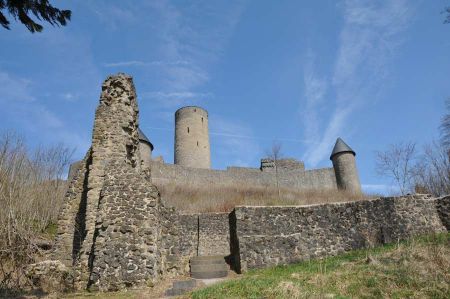Adenau - small town at Nordschleife and Nürburg castle ruins
- Written by Portal Editor
In recent years, complex reports about the traditional Nürburgring, the infamous Nordschleife with its racing history, especially Formula 1 and the "Rock am Ring" music festival, have caused rather negative headlines for a wonderful region, which unfairly takes a shine to it Edge was moved.
Maybe the time has come to say something positive again, even if there won't be a rush of visitors like the events mentioned above. The region simply has a wide range of cultural assets to offer, with intact nature and friendly people, so we are always happy to come back and share this with others.
The view extends into the circuit of the Formula 1 track
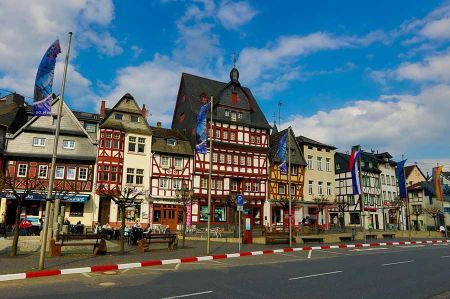 Now, after the tour along the Ahr, it was time to visit the ruins of the summit castle "Nürburg", which is located high up on the mountain and has been shown in silhouette so many times live on TV during various major events. Otherwise there is little going on in the area around the "Nürburg" castle, which you can reach from the B 258, passing the racing museum directly on the Formula 1 track and then turning onto the Nordschleife circuit. The ruins are clearly visible from afar, so the parking lot below the castle is also easy to find. A short climb to the castle shouldn't deter anyone, as the view from the top is definitely worth the effort. The view extends into the circuit of the Formula 1 track as well as the entire area surrounding the Eiffel.
Now, after the tour along the Ahr, it was time to visit the ruins of the summit castle "Nürburg", which is located high up on the mountain and has been shown in silhouette so many times live on TV during various major events. Otherwise there is little going on in the area around the "Nürburg" castle, which you can reach from the B 258, passing the racing museum directly on the Formula 1 track and then turning onto the Nordschleife circuit. The ruins are clearly visible from afar, so the parking lot below the castle is also easy to find. A short climb to the castle shouldn't deter anyone, as the view from the top is definitely worth the effort. The view extends into the circuit of the Formula 1 track as well as the entire area surrounding the Eiffel.
Count Ulrich is considered to be the builder of the Nürburg
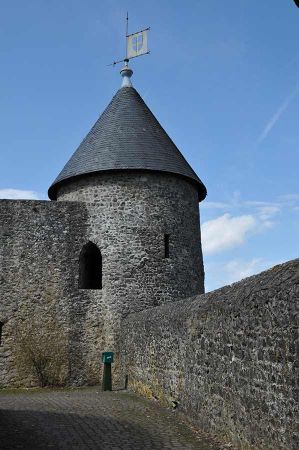 Traces of excavations indicate that even in Roman times they knew how to use the landmark of the 678 meter high volcanic basalt cone, which was visible from afar. As in other Roman settlement areas, there were a number of Roman roads across the Eiffel that connected important cities such as Cologne, Trier, Mainz and Xanten, to name just a few of the main towns. The traces on the Nürburg indicate the presence of a signal station that was once used to secure the Roman roads.
Traces of excavations indicate that even in Roman times they knew how to use the landmark of the 678 meter high volcanic basalt cone, which was visible from afar. As in other Roman settlement areas, there were a number of Roman roads across the Eiffel that connected important cities such as Cologne, Trier, Mainz and Xanten, to name just a few of the main towns. The traces on the Nürburg indicate the presence of a signal station that was once used to secure the Roman roads.
It was not until the Middle Ages that the volcanic basalt cone was "discovered" again as the foundation of the fortress and construction of a castle began, as confirmed in a document from 1166 using the name Noureberg or Mons Nore. The builder of the Nürburg is Count Ulrich, who is named in another document from 1169, although his father Dietrich I of Are had already started building a refuge on the mountain. In the following years, Count Ulrich's descendants called themselves the "Lords of Nürburg and Are". When the last descendants of the von Nürburg family died out, the castle passed to the Archdiocese of Cologne in 1290, who appointed a bailiff to administer it.
Capture of Nürburg during the Thirty Years' War
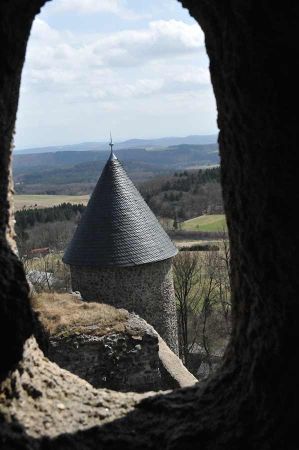 Initially planned and implemented purely as a refuge, only the rectangular core castle was built. Between 1340 and 1369, under the bailiff Johann von Schleiden, ramparts were built as a second fortification ring around the core castle. A third ring was created in the 15th century to fortify the previously unprotected Burgmann houses.
Initially planned and implemented purely as a refuge, only the rectangular core castle was built. Between 1340 and 1369, under the bailiff Johann von Schleiden, ramparts were built as a second fortification ring around the core castle. A third ring was created in the 15th century to fortify the previously unprotected Burgmann houses.
Despite extensive restoration in the 16th century, the Swedes under General Baudissin managed to capture Nürburg during the Thirty Years' War. In 1633 it was looted and damaged. During the French occupation, the castle complex was almost completely destroyed in 1689.
The view alone is worth the climb.
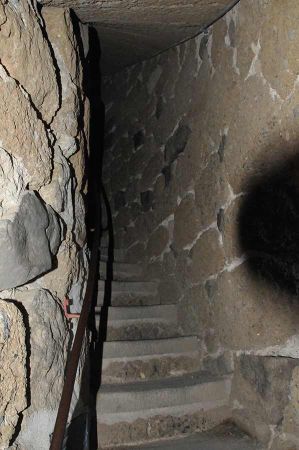 For many years, the keep, which had been preserved until then, was used as a prison until it was no longer usable in 1752. Now the castle complex was completely abandoned and was only used as a quarry. With the arrival of the Prussians in 1818, at least the keep was restored again because they wanted to set up a survey point here. In the course of this work, the outer bailey was almost completely used as a source of building materials, so that hardly any remains of its curtain wall remain.
For many years, the keep, which had been preserved until then, was used as a prison until it was no longer usable in 1752. Now the castle complex was completely abandoned and was only used as a quarry. With the arrival of the Prussians in 1818, at least the keep was restored again because they wanted to set up a survey point here. In the course of this work, the outer bailey was almost completely used as a source of building materials, so that hardly any remains of its curtain wall remain.
Despite the low entry costs, the castle ruins provide a deep insight into the former fortress at this striking point in the landscape, especially through the view from the keep. Just the view is worth the climb.
Dominion of the Counts of Nürburg and Are
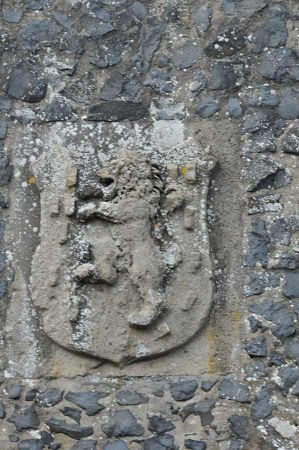 We drive on the L 92 towards Adenau, one of the oldest settlements of the Eiffel in the Nürburg area, because the first records of a place called Adenova can be found as early as 992, which is mentioned in a document from Emperor Otto III. In general, there is a close relationship between the town of Adenau and Nürburg, because the town belonged to the territory of the Counts of Nürburg and Are. In 1162, Count Ulrich von Are gave away his manor in Adenau to the Johanniters, who were also establishing themselves in Germany at the time. The brothers of the order initially tried to care for the sick and pilgrims based on their own models in Jerusalem and Cyprus. With the manor in Adenau, they opened their third branch of the order after Duisburg and Werben on the Elbe.
We drive on the L 92 towards Adenau, one of the oldest settlements of the Eiffel in the Nürburg area, because the first records of a place called Adenova can be found as early as 992, which is mentioned in a document from Emperor Otto III. In general, there is a close relationship between the town of Adenau and Nürburg, because the town belonged to the territory of the Counts of Nürburg and Are. In 1162, Count Ulrich von Are gave away his manor in Adenau to the Johanniters, who were also establishing themselves in Germany at the time. The brothers of the order initially tried to care for the sick and pilgrims based on their own models in Jerusalem and Cyprus. With the manor in Adenau, they opened their third branch of the order after Duisburg and Werben on the Elbe.
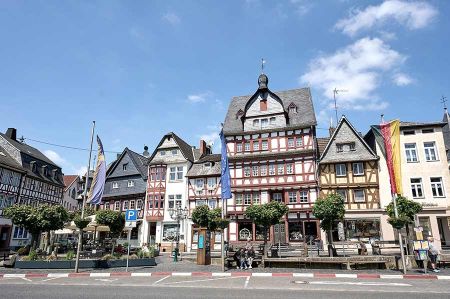 To promote general prosperity, Adenau received market privileges before 1600. In addition to four large fairs, several weekly markets were also held. This privilege was confirmed in 1602 by Elector Ernst of Cologne and in 1647 by Elector Ferdinand of Cologne. Along with this, the leather guild was founded as the first Adenau guild, followed by the wool weavers' guild as early as 1700, and in the 18th century the hammer guild of blacksmiths, locksmiths, carpenters and carpenters followed. Important steps in the development of cities, because these privileges and the city-like constitution with a mayor and a council set Adenau apart from many other places at the beginning of the 17th century. That's why Adenau was also called spots or freedom.
To promote general prosperity, Adenau received market privileges before 1600. In addition to four large fairs, several weekly markets were also held. This privilege was confirmed in 1602 by Elector Ernst of Cologne and in 1647 by Elector Ferdinand of Cologne. Along with this, the leather guild was founded as the first Adenau guild, followed by the wool weavers' guild as early as 1700, and in the 18th century the hammer guild of blacksmiths, locksmiths, carpenters and carpenters followed. Important steps in the development of cities, because these privileges and the city-like constitution with a mayor and a council set Adenau apart from many other places at the beginning of the 17th century. That's why Adenau was also called spots or freedom.
Construction of the Nürburgring Nordschleife was a project to promote the region
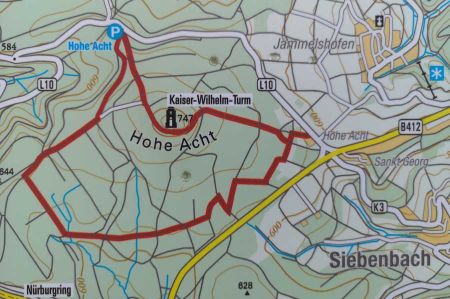 With the beginning of industrialization and the migration of large parts of the population, the Adenau region became one of the poorest districts in Prussia. Complex infrastructure measures should help. In 1888, Adenau was connected to Remagen am Rhein by a railway line via Dümpelfeld, Altenahr and Ahrweiler, and in 1912 to Jünkerath by another railway line. The construction of the Nordschleife of the Nürburgring was also a project to promote the region.
With the beginning of industrialization and the migration of large parts of the population, the Adenau region became one of the poorest districts in Prussia. Complex infrastructure measures should help. In 1888, Adenau was connected to Remagen am Rhein by a railway line via Dümpelfeld, Altenahr and Ahrweiler, and in 1912 to Jünkerath by another railway line. The construction of the Nordschleife of the Nürburgring was also a project to promote the region.
Perhaps promoting soft tourism would have been a more viable solution. But it's never too late. Because the problem of the structurally weak region is more relevant than ever.
Please read as well:
Beginning 70s - Emerson, Lake and Palmer and HR Giger
Fendt-Caravan – a dream comes true – “Work” and “Connect”
https://www.alaturka.info/en/general/6324-adenau-small-town-at-nordschleife-and-nuerburg-castle-ruins#sigProIdda0175a2b8
